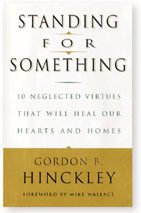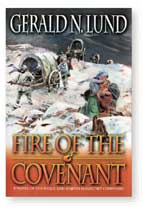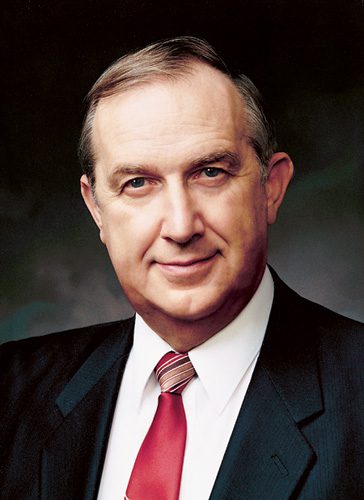By Richard H. Cracroft
By the time you read this issue of Brigham Young Magazine the national publication of President Gordon B. Hinckley’s Standing for Something: 10 Neglected Virtues That Will Heal Our Hearts and Homes(New York: Random House, 2000; 193 pp.; $24) will no longer be news, nor will the fact that television pundit Mike Wallace, of 60 Minutesfame, has written a sprightly and engaging foreword to this landmark book.
Latter-day Saints take pleasure in the national attention being given President Hinckley’s kindly but prophetic reminder to the American people, ourselves included, of the peril which will ensue if we sell our spiritual birthright for a mess of godless immorality and self-indulgent materialism.
What’s more, we delight in the literary quality of this book. Standing for Somethingis a clear, crisply and skillfully written call to national repentance and an invitation to return as fast as we can to the old verities. Sounding like a contemporary Alma, President Hinckley undertakes to persuade Americans to seek the healing of a nation which is morally and spiritually ill and rapidly sinking into bondage. He insists that any reformation of our public institutions will only follow a retrenching of ourselves, our families, and our faith in God.
His essays in part 1, on the 10 neglected virtues, are lively, focused, well-illustrated discussions of love, honesty, morality, civility, learning, forgiveness and mercy, thrift and industry, gratitude, optimism, and faith. Part 2, “The Guardians of Virtue,” examines marriage and the family as the only sure instruments for re-establishing the neglected virtues in our national consciousness.
In his epilogue, “The Loneliness of Moral Leadership,” President Hinckley calls for “men and women who are willing to stand for something” (p. 167) to stand up against “the forces of evil,” which have never before been “so blatant, so brazen, so aggressive as they are at the present time” (p. 170). He calls upon all Americans to humble themselves before God and to stand up, “in every arena of our lives, for the virtues that will make our individual lives, our families, and our society strong and vibrant” (p. 178).
Full of anecdotes from personal experience, scripture, literature, history, and biography, Standing for Something is undeniably the product of a keen mind, a great soul—and divine inspiration. President Hinckley does all of us proud and, more importantly, makes all of us eager to stand for something, now!
And if you are casting about for an individual whose life exemplifies steadfast standing for integrity and gospel truth, you will want to read James P. Bell’s excellent account of the life and ministry of President James E. Faust, In the Strength of the Lord: The Life and Teachings of James E. Faust(Salt Lake City: Deseret Book, 1999; 487 pp.; $22.95). At President Faust’s request, Bell has kept his account of Elder Faust’s rich and faithful life and discipleship to a sparse 250 pages, in order to devote some 230 pages to presenting—by topic and alphabetically from “Abortion” to “Youth”—a digest of his gospel teachings. This is a good book about a good man who has served faithfully as bishop, stake president, assistant to the Twelve, Apostle, and Counselor in the First Presidency, and lovingly as son, husband, father, grandfather, great-grandfather—and friend.
Elder Neal A. Maxwell of the Quorum of the Twelve Apostles was recently given the Award in Devotional Literature by the Association for Mormon Letters (AML) for One More Strain of Praise(Salt Lake City: Bookcraft, 1999; 121 pp.; $16.95), his moving book of meditations about life, the end of life, and enduring to the end. Incidentally, AML also honored two other books recently noted in this column: Anne Perry’s landmark Mormon fantasy novel,Tathea, and Mary Clyde’s fine collection of short stories, Survival Rates (Book Nook, winter 1999–2000). Also noteworthy is the awarding of the David W. and Beatrice C. Evans Biography Award for 1999 to Davis Bitton’s superbGeorge Q. Cannon: A Biography(Book Nook, spring 2000).
A host of notable gospel doctrine studies continues to stream from LDS presses. Two recent works which I found to be rich reads are The Redeemer: Reflections on the Life and Teachings of Jesus the Christ(Salt Lake City: Deseret Book, 2000; 342 pp.; $21.95), which presents essays on the Savior by Robert L. Millet, Ann N. Madsen, Stephen R. Covey, Camille Fronk, Brent L. Top, Truman G. Madsen, Richard Neitzel Holzapfel, and Gerald N. Lund. And inAn Epistle from the New Testament Apostles(Salt Lake City: Bookcraft, 1999; 204 pp.; $19.95) John W. Welch, the BYU Robert K. Thomas Professor of Law, has arranged by theme the 21 New Testament epistles of Peter, Paul, John, James, and Jude, as if they were a single letter. This fresh approach re-opens these letters and enables new understanding of their vital messages.
Don’t miss Thomas F. Rogers’ A Call to Russia: Glimpses of Missionary Life(Provo, Utah: BYU Studies, 1999; 191 pp.; $11.95). Rogers—BYU professor of Russian, playwright, and former president (1993–96) of the Russia St. Petersburg Mission—has made an important addition to the strangely sparse genre of LDS mission narrative. This wonderfully readable account, drawn from Rogers’ mission journals, captures (as only a lover of the gospel, his fellow beings, and language and literature could) Mormon missionary life as experienced by himself, his wife and daughter, and the sisters and elders who served with him. “The journal records,” writes Rogers, “my personal response, my musings over . . . events as they occurred, mostly in others’ lives, sometimes in my own. . . . Those three years were truly a time of awakening and spiritual discovery” (p. xiv). Rogers’ account is full of evidences of the Lord at work, nudging His children towards insight, truth, repentance, and ensuing growth. After all, there is no more exciting story than a man or woman discovering the reality of the Father, the Son, and the Holy Spirit, and his or her place in Their higher reality. A Call to Russiais a memoir of the hope and heartache, sorrow and joy, and struggle and growth which every missionary—and every mission president—experiences on the far-flung battlefronts of the soul.
Professor R. Lanier Britsch recollects such a little-known and far-flung battleground in Nothing More Heroic: The Compelling Story of the First Latter-day Saint Missionaries in India(Salt Lake City: Deseret Book, 1999; 313 pp.; $22.95). Britsch recounts the opening of the Calcutta East India Mission (including Burma, Ceylon, and Siam) in the voice of Amos Milton Musser, one of the eight missionaries “called out” during the August 1852 General Conference. Britsch, who also wrote From the East: The History of the Latter-day Saints in Asia,1851–1996 (1998), follows the intrepid eight through their daunting but nearly fruitless efforts to establish the Church in a non-Christian land, where the only real converts were to be found among the British residents. In 1856, President Brigham Young directed the missionaries to close the mission and gather the handful of Saints to the Rocky Mountains. It is a fascinating account.
Finally, some brief notices of several recent works of LDS fiction: Gerald N. Lund’s Fire of the Covenant(Salt Lake City: Bookcraft, 1999; 764 pp.; $25.95), subtitled, A Novel of the Willie and Martin Handcart Companies,makes personal, as Lund can do nonpareil, the terrible tragedy of November 1856. In a happier vein is Marilyn Arnold’s Sky Full of Ribbons(American Fork, Utah: Covenant Communications, 2000; 220 pp., plus a Reader’s Guide; $13.95), which once again follows the adventures of English professor Delia McGrath and her starchy mother Polly in this sparkling conclusion to her Desert Song and Song of Hopetrilogy. Chris Heimerdinger, in The Golden Crown(American Fork, UT: Covenant Communications, 1999; 338 pp.; $14.95), takes us, via that now-familiar cavern in northern Wyoming, back to first-century Palestine, Rome, and Greece, in the seventh volume of the indefatigably imaginative Heimerdinger’s Tennis Shoes Adventure Series. This time the righteous warriors save several New Testament books for posterity.
Janene Wolsey Baadsgaard has done it again–twice–in Expecting Joy(Salt Lake City: Bookcraft, 1999; 97 pp.; $9.95), a funny novel in which she follows the determined “Sister Bishop” and mother of nine (plus one!) back to school to complete her BYU degree; and in Grin & Share It: Raising a Family with a Sense of Humor(Salt Lake City: Deseret Book, 1999; 118 pp.; $15.95) she ladles out funny spoonfuls of nonfictional advice about how to keep your wits and humor about you when families really seem to be forever.
Finally, Carol Lynn Pearson, who moved us in The Lesson: A Fable for Our Times(Book Nook, winter 1999–2000), now moves us again with two companion volumes: What Love Is: A Fable for Our Times(Salt Lake City: Gibbs-Smith, 1999; 30 pp.; $9.95), a tender fable about love and marriage; and Will You Still Be My Daughter: A Fable for Our Times(Salt Lake City: Gibbs-Smith, 2000; 28 pp.; $9.95), a gentle probing of the friendship between mother and daughter. Each volume is blessed by the striking art of Kathleen Peterson.
Richard H. Cracroft is the Nan Osmond Grass Professor in English at BYU; he is also the director of the Center for the Study of Christian Values in Literature and bishop of the BYU 203rd Ward.









